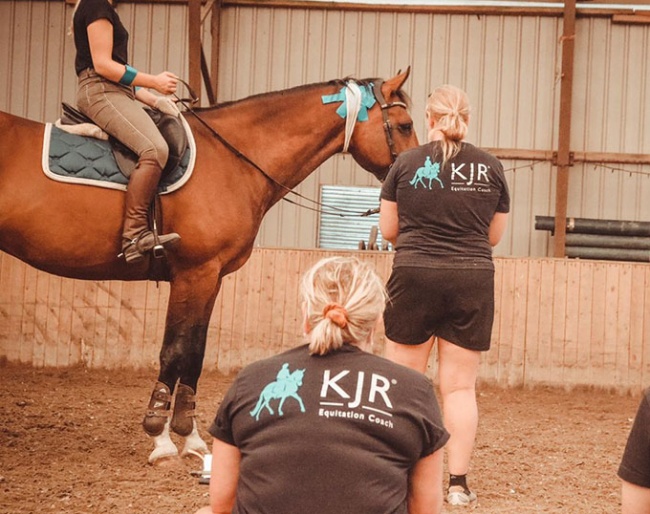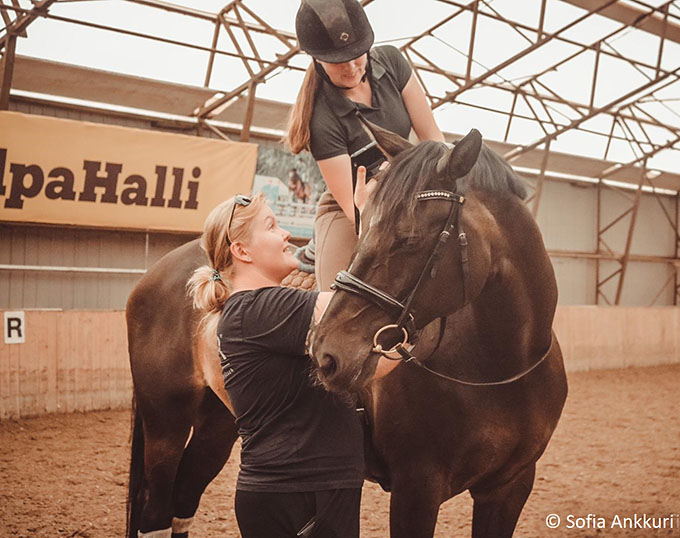
Riders try to achieve a good contact in many ways. The quality of rein contact is a very informative indicator of balance of both horse and rider. Rein contact is an instant and precise information channel that gives the rider a lot of information about the horse’s state of balance, symmetry and muscle tone.
Rein contact affects the rideability of the horse and it must be schooled to the horse at an as early stage as possible, so that the horse can understand the rein aids and move in balance. The rider needs to know how much contact is optimal and how to get there. To use the reins softly, the horse must remain supple in the mouth, neck and the rest of the body. Any pressure or tension always changes the way how the horse is using his body and any problems with contact should be addressed and solved as quickly as possible. To say it short: don´t wait until the problem goes away, help the horse right away into a better balance and good frame.
When riding, the quality of rein contact starts with the physical and mental balance of the horse and rider. The rider’s seat defines how precisely the rider can use her hands and the rein aids. For a good forward thinking hand the rider needs a balanced and relaxed yet effective classical seat. This kind of seat allows precise aids and it helps the horse to move in a relaxed and efficient way.
Problems need to be solved instantly
When there are problems with the rein contact, the contact usually tends to become heavy, empty or uneven in different ways. It is common that problems start to cumulate and last for a longer period of time. It is commonly thought that problems in contact disappear when the horse becomes stronger or more balanced in the body. We should instead find out how we can help the horse instantly to find a better balance and a softer contact that allows the rider to communicate with the horse more precisely.

their own riding during the session.
Wilma Erkkilä and Release Me
focusing on their results.
Is the feeling correct?
To find out how well riders feeling correlates with what actually happens in their contact and to improve the contact skills of the riders, we wanted to know what kind of contact riders try to achieve and how much contact they actually use in their daily training when they ride their own horses. This is not research; this is what we have noticed in our daily work in helping the riders to improve their own riding. We wish this will give inspiration for further research about the topic.
Eleven riders (dressage and showjumping) volunteered to get detailed information of their own daily training routines with wearable technical equipment that is commonly used in human physiotherapy and training of human and equine athletes. We measured rein contact and followed muscle activity with wearable superficial EMG sensors on horses and riders while they were riding. More information of EMG results will be published later.
The horses were in normal training, competing in dressage or showjumping on different levels (from elementary up to Intermediate I and 130cm) and ridden by their own riders with a snaffle. The measurement was done in an indoor riding arena in a relaxed warm-up like situation that is part of their daily independent training. The riding exercise for measurement was done on a 20m circle to the right and to the left, one in walk, trot and canter to each direction.
We asked the riders before their ride about their feeling of their own contact. We wanted to know how much contact they approximately assume to use and what is their ideal of a good contact that they try to achieve in their own training. Then the riders were doing some walk, trot and canter on a circle and we asked them again about how they feel about their contact to see if their feeling matches with what we saw in the measurement. For the riders this was interesting, as they could get real time feedback about their own riding. The results were interesting and there was some variation between the feeling and the measured values, which means that there is a need for further measurements and closer investigation of the topic in the future.
Instant improvement can be possible

individual movement strategies, which was one point of
interest
However, we were glad to notice that the relaxation and quality of contact can be improved instantly in a way that we not only feel, but that we also can show to the rider, which is a very promising finding and needs further measurements with more horses and riders. Our work around this will continue to bring riders and the whole equine community more information about this important topic.
Finnish measurement team at the first phase: Niina Kirjorinne (Dressage Trainer and Animal Physiotherapist specialised in horse and rider biomechanics), Eija Nordlund (Physiotherapist, Animal Physiotherapist), Minna Kreivi (Physiotherapist).

Photos © Sofia Ankkuri
Related Links
Functionality in Equitation: Collection in Walk, a Training Exercise
Functionality in Equitation: Skin Damage from Leg Aids
Functionality in Equitation: The Forward Thinking Hand
Functionality in Equitation: Balance, the Key in Equitation
Functionality in Equitation: Aim for Good Movement
Functionality in Equitation: Fascia and Movement
Functionality in Equitation: Fascia Treament - Surface Has a Deep Effect
Meet Niina Kirjorinne, Classical Dressage Rider and Physiotherapist
Effect of Noseband Positioning to Fascial and Neural Dynamics of the Head